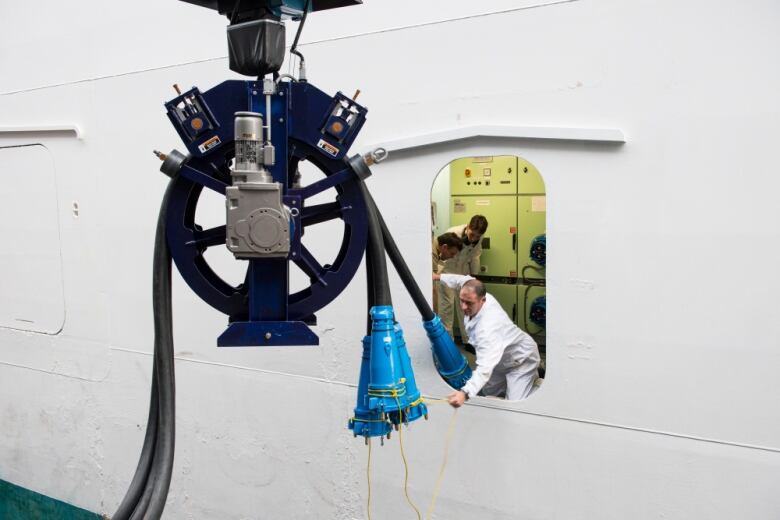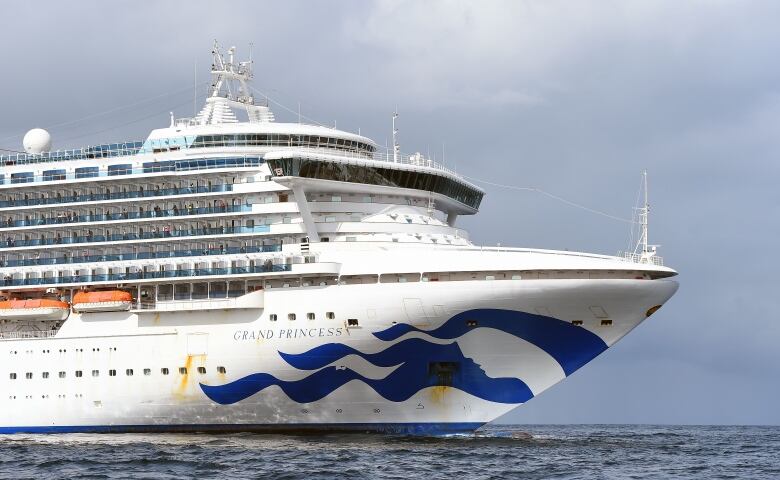Cruise ships bring lots of business to Halifax along with pollution from dirty fuel, critics say
With little public data, business owner wonders what impact ships have on local air and water quality

The arrival of cruise ships boosts sales for Mimi Fautley's Halifax knitting supply store, but the business owner says undocumented pollution from the industry worries her.
Fautley estimates sales to cruise ship passengers account for 10 to 20 per cent of The Loop's summer revenue. But, without publicly available data, Fautley said she's left to speculate on the level of pollution the ships are bringing into the community.
The Port of Halifax doesn't currently track emissions from cruise ships.
"There are issues around cruise ships [that] I feel have been unacknowledged in the time that we've also grown dependent on them," she said. "I think we really need to start measuring the quantity of emissions in the city over time and how that changes when the cruise ships are here."
About150 cruise ships are expected todock in Halifax this season, down from 179 the year before the industry's two-year hiatus in Canada due to COVID-19 restrictions. The Port of Halifax estimates that in 2019, the economic impact of the cruise industry in Halifax and the surrounding area was $165 million.

Environmental groups have criticized the sector for its air and ocean pollution track record. A 2019 study found passengers and staff aboard four cruise ships werelikely exposed to high levels of particle pollution from the ships' exhaust.
Hrvoje Cari, a researcher at the Institute for Tourism in Zagreb, Croatia, argued the cost-benefit relationship between cruise tourism and coastal communities has worsened over the years as ships get larger.
"They have a tendency to mimic destinations," Cari said. "So the cruise guests do not leave and spend nearly as much money in a port in a destination as they did maybe 10, 15, 20 years ago."
Cari is one of the authors of a recent report on the environmental and human health impacts of cruise tourism.
Air, ocean emissions
Most cruise ships run on heavy fuel oil, a cheap crude oil derivative that is high in pollutants that have been linked to acid rain, ocean acidification, and various health conditions, Cari's report notes.
Internationalregulations introduced in 2020reduced the allowable sulphur content of marine fuel to a level below what is typical for heavy fuel oil.
To comply with the regulations, ships can install exhaust cleaning systems on engines, also known as scrubbers, which remove some pollutants from ship exhaust.
But exhaust from ships equipped with scrubbers and the water discharged from the systems could still contain pollutants, Cari's report notes.

In an emailed statement, a spokesperson for Transport Canada said the department is working on an approach to reduce scrubber discharge.
"Transport Canada recognizes concerns regarding scrubber washwater discharges in Canadian waters and continues to study the environmental impacts," it said.
Donna Spalding, a spokesperson for Cruise Lines International Association the world's largest cruise industry association said the industry is focused on transitioning to liquified natural gas (LNG) and other cleaner fuels for its new ships. The association has approximately 270 ships in its fleet.
Spalding said members currently have four LNG-fuelled ships and 22 more on order, adding that some ships that use heavy fuel oil uselow-sulphur fuel while idling in port. She could not provide a breakdown of the number of ships using other fuels.
Shore power
In 2014, the Port of Halifaximplemented shore power, a technology that allows cruise ships to turn off their auxiliary engines and plug into the electrical grid while in port.
The system can accommodate one ship at a time, and only appropriately configured vessels can plug in, said Lane Farguson, spokesperson for the Halifax Port Authority.
He said the system can be expanded to accommodate more ships if there is demand from the industry.

Cari said these systems are only as clean as the grid that powers them.
Given that Nova Scotia'sprimary source of electricity is coal, he said plugging in is "not much of an improvement" over idling.
Cari said it should be up to governments to provide precise information on the economic and environmental impacts of cruise ships.
Monitoring, enforcement lacking in Canada
Ross Klein, an internationally recognized expert on the cruise industry, said the monitoring and enforcement of cruise industry regulations in Canada is severely lacking.
"You can have all the regulations you want," Klein said. "But unless you're actually observing, monitoring, and actually enforcing, it doesn't mean anything."
Klein has documented hundreds of environmental violations and fines from media reports and public documents on his website,cruisejunkie.com.
The fines range from violations of wastewater quality standards to a 2019 fine against Carnival Corp. of $40 million fordischarging oily waste from its Princess Cruise Linesships and covering it up.

He pointed to Alaska, where onboard observers ensured compliance with regulations from 2006 to 2019, as "probably the most effective" model of monitoring he's seen in action across the globe.
Klein noted that relatively few violations had been reported on Canada's Pacific coast.
"I guess the ships are just in good behaviour when they're in Canada," he said.
Transport Canada says it has no plans to add observers on board cruise ships but it does conduct about 1,200 inspections on domestic and foreign-flagged vessels,including cruise ships.
The Port of Halifax is considering expanding the use of a new rebate program to cruise operations to reduce emissions, Farguson said. It rewards low-emitting cargo ships with a $500 to $1,000 incentive.
Fautley said she'd like to see cruise emissions numbers at the port made public.
"I think that the only reason we're not talking about this is that people don't know those numbers," she said.
"I'd like to know that we have an understanding of what the impact is of having these ships come this frequently."
She added she wants to see Halifax to play a larger role in advocating for the mitigation of environmental impacts of cruise tourism.
MORE TOP STORIES












_(720p).jpg)


 OFFICIAL HD MUSIC VIDEO.jpg)
.jpg)



























































































